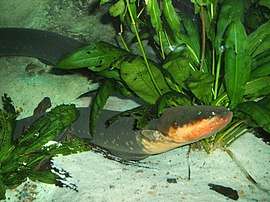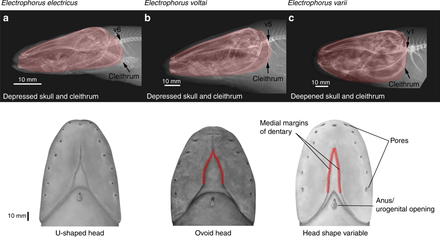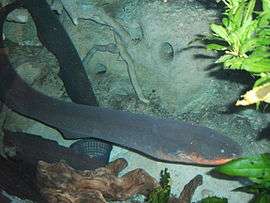Electric eel
The electric eel (Electrophorus electricus, other species proposed)[2] is a South American electric fish. Until 2019, it was classified as the only species in its genus.[2] Despite the name, it is not an eel, but rather a knifefish.
| Electric eel | |
|---|---|
 | |
| Electric eel at the New England Aquarium, United States | |
| Scientific classification | |
| Kingdom: | |
| Phylum: | |
| Class: | |
| Order: | |
| Family: | |
| Genus: | Electrophorus T. N. Gill, 1864 |
| Species: | E. electricus |
| Binomial name | |
| Electrophorus electricus (Linnaeus, 1766) | |
| Synonyms | |
|
Gymnotus electricus | |
Anatomy

The electric eel has an elongated, cylindrical body, typically growing to about 2 m (6 ft 7 in) in length, and 20 kg (44 lb) in weight, making them the largest species of the Gymnotiformes.[3] Their coloration is dark gray-brown on the back and yellow or orange on the belly. Mature females have a darker color on the abdomen.
They have no scales. The mouth is square, and positioned at the end of the snout. The anal fin extends the length of the body to the tip of the tail.
As in other ostariophysan fishes, the swim bladder has two chambers. The anterior chamber is connected to the inner ear by a series of small bones derived from neck vertebrae called the Weberian apparatus, which greatly enhances its hearing capability. The posterior chamber extends along the whole length of the body and maintains the fish's buoyancy.
E. electricus has a vascularized respiratory system with gas exchange occurring through epithelial tissue in its buccal cavity.[4] As obligate air-breathers, electric eels must rise to the surface every ten minutes or so to inhale before returning to the bottom. Nearly eighty percent of the oxygen used by the fish is obtained in this way.[5]
Despite its name, the electric eel is not closely related to the true eels (Anguilliformes) but is a member of the neotropical knifefish order (Gymnotiformes), which is more closely related to the catfish.
Physiology

The electric eel has three pairs of abdominal organs that produce electricity: the main organ, the Hunter's organ, and the Sach's organ. These organs make up four fifths of its body, and give the electric eel the ability to generate two types of electric organ discharges: low voltage and high voltage. These organs are made of electrocytes, lined up so a current of ions can flow through them and stacked so each one adds to a potential difference.[6]
When the eel finds its prey, the brain sends a signal through the nervous system to the electrocytes.[6] This opens the ion channels, allowing sodium to flow through, reversing the polarity momentarily. By causing a sudden difference in electric potential, it generates an electric current in a manner similar to a battery, in which stacked plates each produce an electric potential difference.[6] Electric eels are also capable of controlling their prey's nervous systems with their electrical abilities; by controlling their victim's nervous system and muscles via electrical pulses, they can keep prey from escaping or force it to move so they can locate its position.[7][8]
In the electric eel, some 5,000 to 6,000 stacked electroplaques can make a shock up to 860 volts and up to 1 ampere of current.[9][10] This level of current is reportedly enough to produce a brief and painful numbing shock likened to a stun gun discharge, which due to the voltage can be felt for some distance from the fish; this is a common risk for aquarium caretakers and biologists attempting to handle or examine electric eels.[11]
Electric eels use electricity in multiple ways. Low voltages are used to sense the surrounding environment. High voltages are used to detect prey and, separately, stun them. Pairs of high voltage pulses separated by 2 milliseconds are used to detect and locate prey by causing them to twitch involuntarily; the electric eel senses this movement. A string of high voltage pulses at up to 400 per second are then used to attack and stun or paralyze the target, at which point the electric eel applies a suction-feeding bite.[9]
The Sach's organ is associated with electrolocation.[12] Inside the organ are many muscle-like cells, called electrocytes. Each cell can only produce 0.15 V, though the organ can transmit a signal of nearly 10 V overall in amplitude at around 25 Hz in frequency. These signals are emitted by the main organ; the Hunter's organ can emit signals at rates of several hundred hertz.[12]
The electric eel is unique among the Gymnotiformes in having large electric organs that can produce potentially lethal discharges that allow them to stun prey.[13] Larger voltages have been reported, but the typical output is sufficient to stun or deter virtually any animal. Juveniles produce smaller voltages (about 100 V). They can vary the intensity of the electric discharge, using lower discharges for hunting and higher intensities for stunning prey or defending themselves. They can also concentrate the discharge by curling up and making contact at two points along its body.[14] When agitated, they can produce these intermittent electric shocks over at least an hour without tiring.
The electric eel also possesses high frequency–sensitive tuberous receptors, which are distributed in patches over its body. This feature is apparently useful for hunting other Gymnotiformes.[12]
Electric eels have been used as a model in the study of bioelectrogenesis.[15] The species is of some interest to researchers, who make use of its acetylcholinesterase and adenosine triphosphate.[16][17]
Michael Faraday extensively tested the electrical properties of an electric eel, imported from Suriname. For a span of four months, Faraday carefully and humanely measured the electrical impulses produced by the animal by pressing shaped copper paddles and saddles against the specimen. Through this method, Faraday determined and quantified the direction and magnitude of electric current, and proved the animal's impulses were in fact electrical by observing sparks and deflections on a galvanometer.[18]
Bionics
Researchers at Yale University and the National Institute of Standards and Technology argue artificial cells could be built that not only replicate the electrical behavior of electric eel cells, but also improve on them. Artificial versions of the eel's electricity-generating cells could be developed as a power source for medical implants and other microscopic devices.[19]
Ecology and life history
Habitat
Electric eels inhabit fresh waters of the Amazon and Orinoco River basins in South America, in floodplains, swamps, creeks, small rivers, and coastal plains. They often live on muddy bottoms in calm or stagnant waters.[12]
In zoos and private collections
These fish have always been sought after by some animal collectors, but catching them is difficult, because the only reasonable option is to make the eels tired by continually discharging their electricity. The fish's electric organs eventually become completely discharged, allowing the collector to wade into the water in comparative safety.[21]
Keeping electric eels in captivity is difficult and mostly limited to zoos and aquaria, although a few hobbyists have kept them as pets.
The Tennessee Aquarium in the United States is home to an electric eel. Named Miguel Wattson, the eel's exhibit is wired to a small computer that sends out a prewritten tweet when it emits electricity at a high enough threshold.[23][24]
Taxonomic history
The species is so unusual that it has been reclassified several times. When originally described by Carl Linnaeus in 1766, he used the name Gymnotus electricus, placing it in the same genus as Gymnotus carapo (banded knifefish) which he had described several years earlier. It was only about a century later, in 1864, that the electric eel was moved to its own genus Electrophorus by Theodore Gill.[25]
Later the electric eel was considered sufficiently distinct to have its own family, Electrophoridae, but it has since been merged back into the family Gymnotidae, alongside Gymnotus.[13][26][27]
In September 2019, C. David de Santana et al. published work strongly suggesting division of Electrophorus electricus into three species based on DNA divergence, ecology and habitat, anatomy and physiology, and electrical ability. The proposed three species are E. electricus, E. voltai sp. nov., and E. varii sp. nov.[2]
Footnotes
- "Electrophorus electricus". IUCN Red List of Threatened Species. Retrieved 2014-06-07.
- de Santana, C. David; Crampton, William G. R. (2019-09-10). "Unexpected species diversity in electric eels with a description of the strongest living bioelectricity generator" (PDF). Nature Communications. 10 (1): 4000. Bibcode:2019NatCo..10.4000D. doi:10.1038/s41467-019-11690-z. PMC 6736962. PMID 31506444. Archived from the original (PDF) on 2019-09-10. Retrieved 2019-09-10.
- Albert, J.S. (2001). "Species diversity and phylogenetic systematics of American knifefishes (Gymnotiformes, Teleostei)". Misc. Publ. (190): 1–127. hdl:2027.42/56433.
- Boutilier, Robert (1990). Vertebrate Gas Exchange: From Environment to Cell. Advances in Comparative & Environmental Physiology 6. Springer-Verlag Berlin. p. 285. ISBN 9783642753800.
- Johansen, Kjell (1968). "Gas Exchange and Control of Breathing in the Electric Eel, Electrophorus electricus". Z. Vergl. Physiol. 61 (Volume 61, Number 2 / June, 1968): 137–163. doi:10.1007/BF00341112.
- Xu, Jian; Lavan, David (2008). "Designing artificial cells to harness the biological ion concentration gradient". Nature Nanotechnology. 3 (11): 666–670. Bibcode:2008NatNa...3..666X. doi:10.1038/nnano.2008.274. PMC 2767210. PMID 18989332.
- Gill, Victoria (2014-12-04). "Electric eels 'remotely control prey'". BBC News.
- "Electric eels remote-control nervous systems of prey". 2015-02-17.
- Catania, Kenneth C. (April 2019). "Shock & Awe". Science American. 320 (4): 62–69.
- The Guardian: Shocking news: world's most powerful electric eel found in Amazon. Retrieved 11 Sep 2019
- Wheeler; et al. (1995). "Practical considerations in the handling and care of electric eels". Journal of Experimental Zoology. 43 (9): 53–57.
- Froese, Rainer and Pauly, Daniel, eds. (2005). "Electrophorus electricus" in FishBase. December 2005 version.
- Nelson, Joseph, S.; Grande, Terry C.; Wilson, Mark V. H. (2016). Fishes of the World (5 ed.). John Wiley & Sons, Inc. ISBN 978-1118342336.
- Catania, Kenneth C. (2015-10-29). "Electric Eels Concentrate Their Electric Field to Induce Involuntary Fatigue in Struggling Prey". Current Biology. 25 (22): 2889–98. doi:10.1016/j.cub.2015.09.036. PMID 26521183. Retrieved 29 October 2015.
- Albert, J.S.; H. H. Zakon; P. K. Stoddard; G. A. Unguez; S. K.S. Holmberg; M. R. Sussman (2008). "The case for sequencing the genome of the electric eel, Electrophorus electricus". J. Fish Biol. 72 (2): 331–354. doi:10.1111/j.1095-8649.2007.01631.x.
- Simon, Stéphanie; Massoulié, J (1997-12-26). "Cloning and Expression of Acetylcholinesterase from Electrophorus". Journal of Biological Chemistry. 272 (52): 33045–33055. doi:10.1074/jbc.272.52.33045. PMID 9407087.
- Zimmermann, H; CR Denston (1976). "Adenosine triphosphate in cholinergic vesicles isolated from the electric organ of Electrophorus electricus". Brain Res. 111 (2): 365–76. doi:10.1016/0006-8993(76)90780-0. PMID 949609.
- Faraday M (1839). "Experimental Researches in Electricity, Fifteenth Series". Philosophical Transactions of the Royal Society. 129: 1–12. doi:10.1098/rstl.1839.0002.
- Xu, Jian; David A. Lavan (2008). "Designing artificial cells to harness the biological ion concentration gradient". Nature Nanotechnology. 3 (11): 666–670. Bibcode:2008NatNa...3..666X. doi:10.1038/nnano.2008.274. PMC 2767210. PMID 18989332.
- Assunção MIS; Schwassmann HO (1995). "Reproduction and larval development of Electrophorus electricus on Marajó Island (Pará, Brazil)". Ichthyological Exploration of Freshwaters. 6 (2): 175–184. ISSN 0936-9902.
- Piper, Ross (2007), Extraordinary Animals: An Encyclopedia of Curious and Unusual Animals, Greenwood Press.
- van der Sleen, Peter; Albert, James S., eds. (2017). Field guide to the fishes of the Amazon, Orinoco, and Guianas. Princeton University Press. p. 331. ISBN 9781400888801. OCLC 1004848434.
- "Electric Eel". Tennessee Aquarium. Retrieved February 1, 2015.
- Phillips, Casey (January 16, 2015). "Snap, crackle, tweet: Tennessee Tech helps aquarium's electric eel make splash on social media". Chattanooga Times Free Press. Retrieved February 1, 2015.
- Jordan, D.S. (1963). The Genera of Fishes and a Classification of Fishes. Stanford University Press. p. 330.
- van der Sleen, P.; J.S. Albert, eds. (2017). Field Guide to the Fishes of the Amazon, Orinoco, and Guianas. Princeton University Press. pp. 330–334. ISBN 978-0691170749.
- Ferraris Jr, C.J.; C.D. de Santana; R.P. Vari (2017). "Checklist of Gymnotiformes (Osteichthyes: Ostariophysi) and catalogue of primary types". Neotrop. Ichthyol. 15 (1). doi:10.1590/1982-0224-20160067.
References
| Wikispecies has information related to Electrophorus electricus |
| Wikimedia Commons has media related to Electrophorus electricus. |
- Catania, K., "The Shocking Predatory Strike of the Electric Eel", Science, Vol.346, No.6214, (5 December 2014), pp. 1231–1234.
- Catania, K.C., "Leaping Eels Electrify Threats, Supporting Humboldt’s Account of a Battle with Horses", Proceedings of the National Academy of Sciences, Vol.113, No.13 (21 June 2016), pp.6979-6984.
- Catania, Kenneth C. (2017). "Power Transfer to a Human during an Electric Eel's Shocking Leap". Current Biology. 27 (18): 2887–2891.e2. doi:10.1016/j.cub.2017.08.034. PMID 28918950.
- Finger S., "Dr. Alexander Garden, a Linnaean in Colonial America, and the Saga of Five 'Electric Eels'", Perspectives in Biology and Medicine, Vol.53, No.3, (Summer 2010), pp. 388–406.
- Finger, S. & Piccolino, M., The Shocking History of Electric Fishes: From Ancient Epochs to the Birth of Modern Neurophysiology, Oxford University Press, (New York), 2011.
- Gervais, R (2017). "Phenomenological Understanding and Electric Eels". Theoria. 32 (3): 293–302. doi:10.1387/theoria.17294.
- Plumb, G., "The 'Electric Stroke' and the 'Electric Spark': Anatomists and Eroticism at George Baker's Electric Eel Exhibition in 1776 and 1777", Endeavour, Vol.34, No.3, (September 2010), pp. 87–94.
- Traeger, L.L.; Sabat, G.; Barrett-Wilt, G.A.; Wells, G.B.; Sussman, M.R. (July 2017). "A Tail of Two Voltages: Proteomic Comparison of the Three Electric Organs of the Electric Eel". Science Advances. 3 (7): e1700523. Bibcode:2017SciA....3E0523T. doi:10.1126/sciadv.1700523. PMC 5498108. PMID 28695212.
- Turkel, W.J., Spark from the Deep: How Shocking Experiments with Strongly Electric Fish Powered Scientific Discovery, Johns Hopkins University Press, (Baltimore), 2013.
External links
| Look up electric eel in Wiktionary, the free dictionary. |
- 1954 educational film about the electric eel from the Moody Institute of Science
